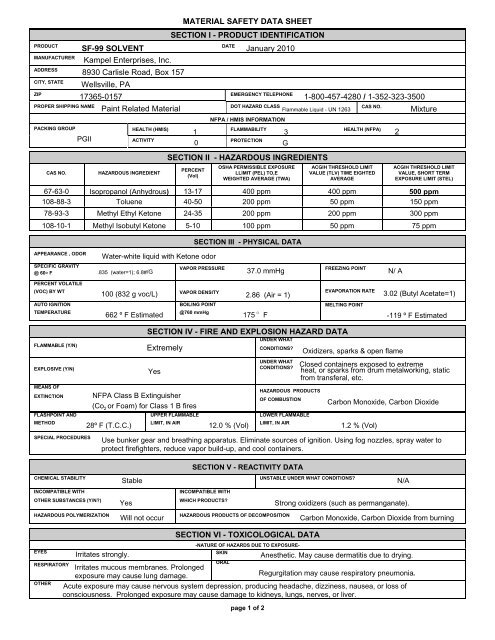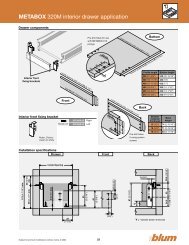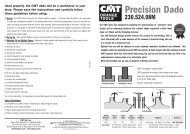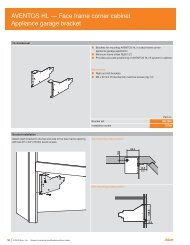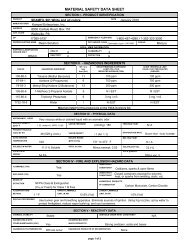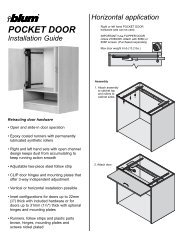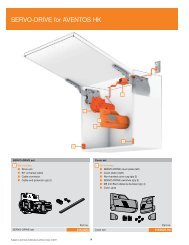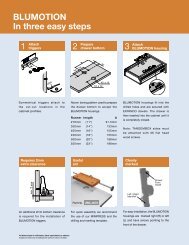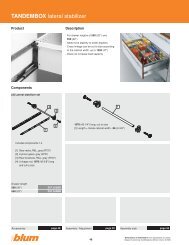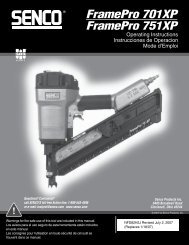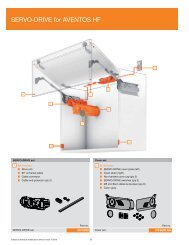ksf99 kampel solvent - Fessenden Hall Inc.
ksf99 kampel solvent - Fessenden Hall Inc.
ksf99 kampel solvent - Fessenden Hall Inc.
You also want an ePaper? Increase the reach of your titles
YUMPU automatically turns print PDFs into web optimized ePapers that Google loves.
PRODUCT<br />
MANUFACTURER<br />
ADDRESS<br />
CITY, STATE<br />
ZIP<br />
PROPER SHIPPING NAME<br />
PACKING GROUP<br />
CAS NO.<br />
MATERIAL SAFETY DATA SHEET<br />
SECTION I - PRODUCT IDENTIFICATION<br />
SF-99 SOLVENT<br />
DATE<br />
January 2010<br />
Kampel Enterprises, <strong>Inc</strong>.<br />
8930 Carlisle Road, Box 157<br />
Wellsville, PA<br />
17365-0157<br />
PGII<br />
Paint Related Material<br />
HEALTH (HMIS)<br />
ACTIVITY<br />
HAZARDOUS INGREDIENT<br />
1<br />
0<br />
EMERGENCY TELEPHONE<br />
DOT HAZARD CLASS Flammable Liquid - UN 1263<br />
NFPA / HMIS INFORMATION<br />
FLAMMABILITY<br />
PROTECTION<br />
SECTION II - HAZARDOUS INGREDIENTS<br />
PERCENT<br />
(Vol)<br />
3<br />
G<br />
OSHA PERMISSIBLE EXPOSURE<br />
LLIMIT (PEL) TO,E<br />
WEIGHTED AVERAGE (TWA)<br />
1-800-457-4280 / 1-352-323-3500<br />
CAS NO.<br />
HEALTH (NFPA)<br />
ACGIH THRESHOLD LIMIT<br />
VALUE (TLV) TIME EIGHTED<br />
AVERAGE<br />
2<br />
Mixture<br />
ACGIH THRESHOLD LIMIT<br />
VALUE, SHORT TERM<br />
EXPOSURE LIMIT (STEL)<br />
67-63-0 Isopropanol (Anhydrous) 13-17 400 ppm 400 ppm 500 ppm<br />
108-88-3 Toluene 40-50 200 ppm 50 ppm 150 ppm<br />
78-93-3 Methyl Ethyl Ketone 24-35 200 ppm 200 ppm 300 ppm<br />
108-10-1 Methyl Isobutyl Ketone 5-10 100 ppm 50 ppm 75 ppm<br />
SECTION III - PHYSICAL DATA<br />
APPEARANCE , ODOR<br />
Water-white liquid with Ketone odor<br />
SPECIFIC GRAVITY<br />
@ 60N F<br />
.835 (water=1); 6.8#/G<br />
VAPOR PRESSURE<br />
37.0 mmHg<br />
FREEZING POINT<br />
N/ A<br />
PERCENT VOLATILE<br />
(VOC) BY WT<br />
AUTO IGNITION<br />
TEMPERATURE<br />
100 (832 g voc/L)<br />
VAPOR DENSITY<br />
662 º F Estimated<br />
BOILING POINT<br />
@760 mmHg<br />
2.86 (Air = 1)<br />
175 " F<br />
EVAPORATION RATE<br />
MELTING POINT<br />
3.02 (Butyl Acetate=1)<br />
-119 º F Estimated<br />
FLAMMABLE (Y/N)<br />
EXPLOSIVE (Y/N)<br />
MEANS OF<br />
EXTINCTION<br />
FLASHPOINT AND<br />
METHOD<br />
SECTION IV - FIRE AND EXPLOSION HAZARD DATA<br />
Extremely<br />
Yes<br />
NFPA Class B Extinguisher<br />
(Co 2 or Foam) for Class 1 B fires<br />
28º F (T.C.C.)<br />
UPPER FLAMMABLE<br />
LIMIT, IN AIR<br />
12.0 % (Vol)<br />
UNDER WHAT<br />
CONDITIONS?<br />
UNDER WHAT<br />
CONDITIONS?<br />
HAZARDOUS PRODUCTS<br />
OF COMBUSTION<br />
LOWER FLAMMABLE<br />
LIMIT, IN AIR<br />
Oxidizers, sparks & open flame<br />
Closed containers exposed to extreme<br />
heat, or sparks from drum metalworking, static<br />
from transferal, etc.<br />
Carbon Monoxide, Carbon Dioxide<br />
1.2 % (Vol)<br />
SPECIAL PROCEDURES<br />
Use bunker gear and breathing apparatus. Eliminate sources of ignition. Using fog nozzles, spray water to<br />
protect firefighters, reduce vapor build-up, and cool containers.<br />
CHEMICAL STABILITY<br />
INCOMPATIBLE WITH<br />
OTHER SUBSTANCES (Y/N?)<br />
Stable<br />
Yes<br />
SECTION V - REACTIVITY DATA<br />
UNSTABLE UNDER WHAT CONDITIONS?<br />
INCOMPATIBLE WITH<br />
WHICH PRODUCTS?<br />
N/A<br />
Strong oxidizers (such as permanganate).<br />
HAZARDOUS POLYMERIZATION<br />
Will not occur<br />
HAZARDOUS PRODUCTS OF DECOMPOSITION<br />
Carbon Monoxide, Carbon Dioxide from burning<br />
EYES<br />
RESPIRATORY<br />
OTHER<br />
Irritates strongly.<br />
SECTION VI - TOXICOLOGICAL DATA<br />
-NATURE OF HAZARDS DUE TO EXPOSURE-<br />
SKIN<br />
ORAL<br />
Anesthetic. May cause dermatitis due to drying.<br />
Irritates mucous membranes. Prolonged<br />
exposure may cause lung damage.<br />
Regurgitation may cause respiratory pneumonia.<br />
Acute exposure may cause nervous system depression, producing headache, dizziness, nausea, or loss of<br />
consciousness. Prolonged exposure may cause damage to kidneys, lungs, nerves, or liver.<br />
page 1 of 2
GLOVES<br />
FOOTWEAR<br />
CONDITIONS TO AVOID<br />
SMALL SPILL<br />
OR LEAK<br />
LARGE SPILL<br />
TRANSFER METHOD<br />
TEMPERATURE RANGE<br />
DISPOSAL<br />
EYE CONTACT<br />
SKIN CONTACT<br />
INHALATION<br />
INGESTION<br />
TRANSPORTATION<br />
REQUIREMENTS<br />
Impervious to organic <strong>solvent</strong>s<br />
Impervious boots<br />
SECTION VII - HANDLING PRECAUTIONS<br />
RESPIRATOR<br />
CLOTHING<br />
-PROTECTIVE EQUIPMENT-<br />
OSHA approved. Charcoal filter<br />
as minimum<br />
Chemical apron<br />
Avoid eye contact. Minimum skin contact, breathing of vapors.<br />
-SPILL PROCEDURES-<br />
EYEWEAR<br />
FACILITY<br />
Chemical goggles<br />
Explosion proof equipment<br />
Eliminate sources of ignition. Use absorbent material and transfer to DOT container. Contact approved Haz Mat<br />
Remedial Agency for disposal.<br />
Isolate from oxidizers, heat and sources of ignition (see Protective Equipment). Stop spill, and dike area to prevent<br />
spread; pump liquid to salvage tank. Contact local Haz Mat emergency response team.<br />
-STORAGE AND DISPOSAL PROCEDURES-<br />
Ground containers to prevent static spark. Prevent vapor accumulation; close containers, ventilate area.<br />
0 " F to 120 " F<br />
WAREHOUSING<br />
Store in structures made for OSHA Class 1 B liquids.<br />
Observe Federal, State, and Local regulations. Recycle spent <strong>solvent</strong> in approved equipment. Contact RCRA approved<br />
Hazardous Waste Recycling/Disposal Facility.<br />
SECTION VIII - FIRST AID<br />
Flush with water for 15 minutes. Get medical attention.<br />
Wipe excess liquid with towel, wash with soap and water. Use moisturizers before and after exposure.<br />
Remove to fresh air. Give oxygen if breathing is difficult, artificial respiration if breathing has stopped.<br />
Call a physician immediately. Do not induce vomiting, as aspiration into lungs may be fatal. Do not give liquids. If<br />
vomiting occurs, keep head below hips to prevent aspiration.<br />
49 CFR, Parts 100 through 177<br />
WORKER & COMMUNITY SARA (Superfund<br />
RIGHT TO KNOW, AND Amendments and<br />
EMERGENCY PLANNING Reauthorization Act) Title III<br />
FEDERAL CLEAN AIR<br />
REQUIREMENTS<br />
FEDERAL HAZARDOUS<br />
CHEMICAL REPORTING<br />
REQUIREMENTS<br />
INGREDIENT<br />
EPA, Clean Air Act and<br />
Amendments of 1990<br />
CERCLA (Comprehensive<br />
Environmental Resource &<br />
Conservation Liability Act) for<br />
substances above reportable<br />
threshold<br />
TYPICAL<br />
PERCENT<br />
(Wt.)<br />
SECTION IX - ENVIRONMENTAL PROTECTION<br />
VOLATILE<br />
ORGANIC<br />
COMPOUND<br />
(VOC)?<br />
-APPLICABLE LAWS AND GOVERNMENT AGENCIES-<br />
EMPLOYEE PROTECTION 29 CFR, Parts 1900 through 1926 (OSHA Hazard<br />
REQUIREMENTS Communication Standard)<br />
EMERGENCY EPA 40 CFR, Parts 117-372; CERCLA (Federal Superfund),<br />
RELEASE National Response Center, SARA Sections 304 and 313<br />
REQUIREMENTS<br />
STATE CLEAN AIR<br />
REQUIREMENTS<br />
STATE HAZARDOUS<br />
CHEMICAL REPORTING<br />
REQUIREMENTS &<br />
EMERGENCY PLANNING<br />
-CERCLA / SARA ENVIRONMENTAL REPORTING-<br />
SARA Section 302 SARA Section 313<br />
REPORTABILITY<br />
QTY. OF<br />
EXTREMELY<br />
HAZARDOUS<br />
SUBSTANCE<br />
THRESHOLD<br />
PLANNING<br />
QUANTITY<br />
PA Air Pollution Control Act, or equivalent<br />
SARA Section 312 Reporting of facility’s chemical<br />
inventory to State Emergency Response Commission,<br />
and Local Emergency Planning Committee<br />
TOXIC<br />
CHEMICAL?<br />
CATEGORY<br />
FOR TOXIC<br />
RELEASE<br />
INVENTORY<br />
CERCLA REPORTABLE<br />
QUANTITY<br />
Toluene 47 Yes Not EHS N/A Yes None 1000 lbs Yes<br />
Methyl Ethyl Ketone 29 Yes Not EHS N/A Yes None 5000 lbs No<br />
Methyl Isobutyl Ketone 5 Yes Not EHS N/A Yes None 5000 lbs No<br />
Isopropyl Alcohol 15 Yes Not EHS N/A Yes None 5000 lbs No<br />
SARA SECTIONS 311, 312 HAZARD CATEGORY (H-1=ACUTE HEALTH;<br />
H-2 = CHRONIC HEALTH; P-3 = FIRE; P-4 = PRESSURE; P-5 = REACTIVE): H-1, H-2, P-3<br />
CARCINOGEN?<br />
The above information is offered in good faith for usage under typical conditions. Recommendations should be reviewed to determine the applicability of this<br />
information in the context of intended usage.<br />
page 2 of 2<br />
Printed in USA<br />
form #wp2010SF99MSDS.1/10


